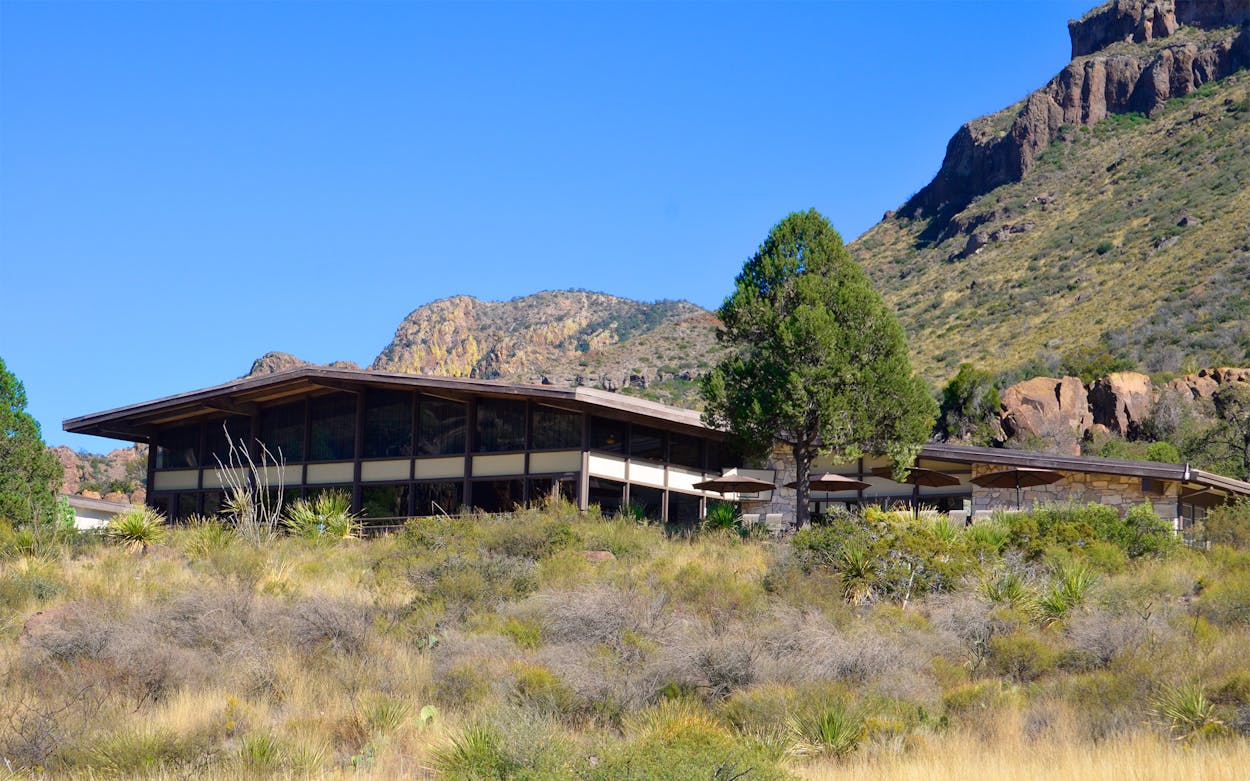This past December, I headed to Big Bend National Park with friends. We were thrilled to have scored a rare last-minute reservation for a night in one of the park’s six historic stone cottages, all built by hand by the Civilian Conservation Corps in the early 1940s. These typically book up about six months in advance, but we got lucky when someone canceled. The cottages, along with 67 motel-style rooms, make up the accommodations at the Chisos Mountains Lodge, the park’s only alternative to camping.
We sipped coffee and ate pancakes, courtesy of our camp stove, on the porch in the morning as a bright blue Mexican jay flitted in the branches above our heads, begging for crumbs. Inside, a framed black and white photo on the wall depicted Lady Bird Johnson, her white cowboy hat at a jaunty angle as she hiked the Lost Mine Trail—the same path we’d climb later that day. After working up an appetite on our trek, we happily headed to the lodge’s main building for dinner in the restaurant. Here, the experience began to falter ever so slightly. Big Bend has seen a surge of visitors in recent years—with attendance rising almost 50 percent in five years—and a long line of diners hungry for the restaurant’s menu of burgers, tacos, and ribeye wound through the small gift shop, nearly spilling out the door onto the cracked cement patio. A faint aroma of sewage wafted over our heads; one of the bathrooms was out of order. We waited almost two hours for our food, and when it arrived, one of our black-bean burgers was, somewhat comically, missing the top of its bun. We didn’t mind a whit, though, because the wait gave us time to watch a spectacular mountain sunset from the lodge’s patio, which offers one of the best views in Texas.
In a few years, that lodge will likely be replaced by a shiny new structure. In a virtual presentation last week, park staff gave the public a first look at the $22 million plan to raze and rebuild the main building, which is damaged beyond repair. While emphasizing that time lines for government construction projects are always fuzzy, park superintendent Bob Krumenaker says he hopes to begin demolition by summer 2023, with a target completion date about two years later, in fall 2025. “The building was built in 1965, and it was built poorly,” he tells Texas Monthly, citing a shifting foundation and numerous cracks in the floors and walls. In addition, park visitation has increased significantly since the lodge first opened its doors, leading to the overcrowding and long lines I saw on my visit. “While it’s not unsafe to occupy, it’s clearly not sustainable,” says Krumenaker, who told Texas Monthly in 2019 that redeveloping the lodge was a priority after his first year on the job at Big Bend. The project presented last week would cost an estimated $22 million, funded primarily by the Great American Outdoors Act.
The redesign is confined almost entirely to the lodge’s main building, which currently houses the restaurant, gift shop, check-in counter, and administrative offices. All guest quarters, including the cottage I stayed in, will remain untouched, as will the visitors’ center down the hill. The convenience store next to the visitors’ center will be demolished, however, since plans call for a similar shop to be integrated into the new main building. The potable water systems in the park are also set to be replaced, which involves digging up myriad pipes and roads.


Krumenaker acknowledges that Texans love the existing lodge and may be sad to see it go. A thorough review, in partnership with the historic-preservation design firm Architectural Resources Group, found that the damage is simply too severe to make a repair effort feasible, either “technically or financially,” he says, adding, “You just cannot patch it anymore with duct tape.” At the same time, he’s excited that the design plan—which he stressed is still in the early stages and subject to change, depending on cost limitations and a historic-preservation review—will preserve the spirit of its predecessor. Renderings depict a glassy, two-story building (offering more space than the current one-story) that looks modern but not showy. With a subtle brown exterior incorporating natural rocks, the new lodge would blend into the mountains, with a footprint no larger than that of the existing building. Its low-slung style and angular shed roof gesture to the mid-century modern traits of the 1965 building, which was part of the National Park Service’s nationwide Mission 66 initiative.
The building is also being conceptualized with climate change in mind. It will be fire resistant (an increasingly important factor, as wildfires are popping up more and more often within the park) and energy efficient, with solar panels, dark sky–friendly lighting, and a smart water-usage plan. “Even though the dining capacity will increase significantly, we’re committed to using no more water in the building than we are now,” Krumenaker says. The outdoor patio and seating area will move from the first floor to the second, in part to keep visitors and wildlife at a safe distance from each other. While that might disappoint Texans who’ve enjoyed watching black bears frolic on the patio, it’s probably better for everyone.
As for how the park will accommodate visitors during construction, that’s “the sixty-four-thousand-dollar question,” the superintendent says. “We are working on that plan, but we don’t have one yet.” Options range from closing all vehicle access to the Chisos Basin—a big disruption that would make the lodging unavailable, but one that would allow the work to proceed much faster—to a piecemeal approach with partial access. To offer a dining option while the restaurant is closed, putting food trucks in the basin campground is one possibility. Bottom line: visitors will need to be patient. “This is a major, major project, so there’s going to be a lot of inconvenience,” Krumenaker says.
Aging infrastructure is an issue that has long plagued not just Big Bend, but America’s national parks as a whole. The park system is notoriously underfunded, resulting in a huge repair backlog that is delicately termed “deferred maintenance.” Nationwide, the cost of overdue repairs is a staggering $12 billion, according to the National Parks Conservation Association. Advocates cheered in 2020, when Congress passed the Great American Outdoors Act to pay for about half those needs. Private donors will need to pitch in too. And given the current volatility of the construction industry, with its sky-high costs and supply chain struggles, it’s possible that the Chisos Mountains Lodge project will need to be significantly modified or simplified to stay within budget.
As for that spectacular sunset view from the lodge’s dining room: Don’t worry, Krumenaker says—once the new building is done, it’ll be even better. The existing lodge has sight lines in only two directions, while the new, glassier one will have them in three, including views of Emory Peak, the park’s tallest mountain, and of Casa Grande, whose towering monolith watches over the Chisos Basin and is bathed in warm, golden light at dawn and dusk. I’ll see you there in 2025.
- More About:
- Big Bend








